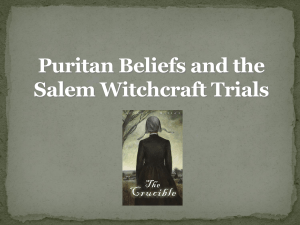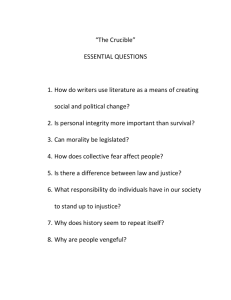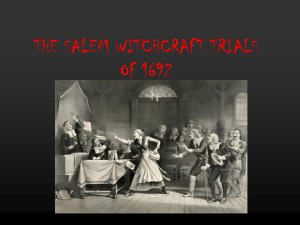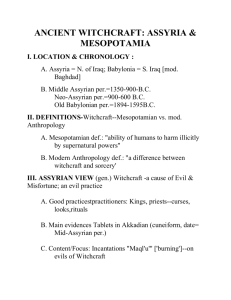Salem Witch Trials ppt - Public Schools of Robeson County
advertisement
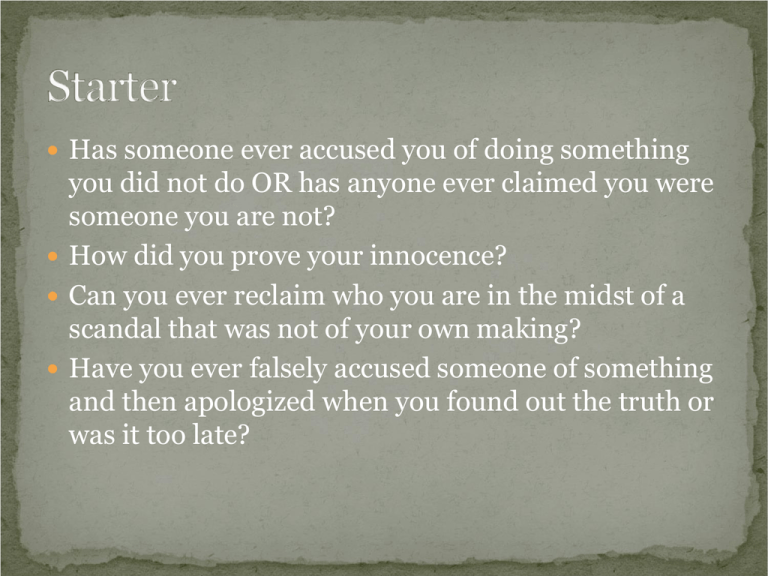
Has someone ever accused you of doing something you did not do OR has anyone ever claimed you were someone you are not? How did you prove your innocence? Can you ever reclaim who you are in the midst of a scandal that was not of your own making? Have you ever falsely accused someone of something and then apologized when you found out the truth or was it too late? https://school.discoveryeducation.com/schooladven tures/salemwitchtrials/story/story.html They wanted to reform their national church by eliminating every shred of Catholic influence Their attempt to “purify” the Church of England and their own lives was based on the teachings of John Calvin Left for the new world in 1620 to escape religious persecution and established the Massachusetts Bay Colony. Total depravity: “In Adam’s fall we sinned all” Humankind is totally sinful through the fall of Adam and Eve and damned for eternity. Predestination: You are “elect” (saved) or “unregenerate” (damned). Salvation belongs to the “elect”, or God’s chosen. No good works will help you become saved. Limited atonement: Christ died only for the “elect”. Grace: You could feel God’s grace in an intense emotional fashion. After receiving grace, you were “reborn” have thenceforth full power to do the will of God and the ability to live uprightly to the end. The Puritan community was a theocracy, a government which blends church and state. The church’s officials were the government’s officials. Thus, church and state were not separate. City upon a Hill Theory: That the new MA Colony would be a place of complete reform (utopia) where God would be found in scripture and a strong work ethic. Education: A strong belief in education was established in order to read the Word of God. The first public school was founded in 1635 and Harvard College became an icon for educating ministers . What do we take away from the Puritans, Planters and Pilgrims? Independence, patriotism, industry, practicality, tolerance, These people were the first to build upon the idea of the American Dream. The idea that a new path could be forged and goals attained. We inherited an emphasis on hard work, a strong sense of religion, duty to country and freedom from oppression. In January 1692, the Salem witch trials began and changed life dramatically for the small farming community of Salem Village, part of the Massachusetts Bay colony. Believing themselves God's chosen people, the Puritan inhabitants of the village followed a strict Puritan code of hard work and religious devotion. They remained vigilant to the workings of the devil in their everyday lives and were dedicated to rooting out evil wherever they perceived its existence However, the restrained and solemn appearance of the Puritan village belied fundamental economic, political, and interpersonal difficulties, which wrought fear, mistrust, and uncertainty throughout the community. This climate gave rise to the witchhunt that followed. Salem Village faced daily challenges closer to home as well. Most families had to support themselves, making their own clothes, planting vegetables, raising meat. Farming was often a painstaking task in the harsh climate and rough, rocky terrain—and a drought or flood could ruin a year’s harvest. An epidemic of smallpox could kill a family. In a world where people saw the Devil lurking behind every misfortune, it is little wonder they believed evil spirits were at work. Church was the cornerstone of 17th century life in New England. Most people in Massachusetts were Puritans—colonists who had left England seeking religious tolerance. But the strict Puritan code was far from tolerant. It was against the law not to attend church—where men and women sat on opposite sides through long services. The Puritan lifestyle was restrained and rigid: People were expected to work hard and repress their emotions or opinions. Individual differences were frowned upon. Even the dark, somber Puritan dress was dictated by the church. Since Puritans were expected to live by a rigid moral code, they believed that all sins—from sleeping in church to stealing food—should be punished. They also believed God would punish sinful behavior. When a neighbor would suffer misfortune, such as a sick child or a failed crop, Puritans saw it as God’s will and did not help. Puritans also believed the Devil was as real as God. Everyone was faced with the struggle between the powers of good and evil, but Satan would select the weakest individuals—women, children, the insane— to carry out his work. Those who followed Satan were considered witches. Witchcraft was one of the greatest crimes a person could commit, punishable by death. In keeping with the Puritan code of conformity, the first women to be accused of witchcraft in Salem were seen as different and as social outcasts: Tituba, a slave; Sarah Good, a homeless beggar; and Sarah Osborne, a sickly old woman who married her servant. Fear of magic and witchcraft was common in New England, as it had been in Europe for centuries. Over 100 alleged witches had been tried and hanged in New England during the 1600s. But the hangings in 1692 Salem would be the last ones in America. In 1692, children were expected to behave under the same strict code as the adults—doing chores, attending church services, and repressing individual differences. Any show of emotion, such as excitement, fear, or anger, was discouraged, and disobedience was severely punished. Children rarely played, as toys and games were scarce. Puritans saw these activities as sinful distractions. But unlike young girls, boys had a few outlets for their imagination. They often worked as apprentices outside the home, practicing such skills as carpentry or crafts. Boys were also allowed to explore the outdoors, hunting and fishing. On the other hand, girls were expected to tend to the house, helping their mothers cook, wash, clean, and sew. Many children learned to read, but most households owned only the Bible and other religious works— including a few that described evil spirits and witchcraft in great detail. There were a few books written for children, but these often warned against bad behavior and described the punishment that children would suffer for sinful acts. Such was the world of Abigail Williams and Betty Parris during the long, dark winter of 1692. There was little to feed their imagination that did not warn of sin and eternal punishment. It is no wonder that the young girls were so captivated by Tituba’s magical stories and fortune-telling games. These activities were strictly forbidden, which must have filled them with fear and guilt. This may have been one reason for their hysterical behavior. And at a time when young girls were forbidden to act out or express themselves, it is easy to see why they were so enraptured by the attention they received when they became “bewitched.” Betty Parris became strangely ill. She dashed about, dove under furniture, contorted in pain, and complained of fever. The cause of her symptoms may have been some combination of stress, asthma, guilt, boredom, child abuse, epilepsy, and delusional psychosis. Talk of witchcraft increased when other playmates of Betty, including eleven-year-old Ann Putnam, seventeen-year-old Mercy Lewis, and Mary Walcott, began to exhibit similar unusual behavior. A doctor called to examine the girls, suggested that the girls' problems might have a supernatural origin. The widespread belief that witches targeted children made the doctor's diagnosis seem increasingly likely. -Douglas Linder 11. Strong belief that Satan is acting in the world. ---------"The invisible world": disease, natural catastrophes, and bad fortune 2. A belief that Satan actively recruits witches and wizards ---------Prior witchcraft cases 3. A belief that a person afflicted by witchcraft exhibits certain symptoms. 4. A time of troubles, making it seem likely that Satan was active. ---------Congregational strife in Salem Village ---------Frontier wars with Indians 5. Stimulation of imaginations by Tituba (slave). 6. Teenage boredom. 7. Confessing "witches" adding credibility to earlier charges. 8. Old feuds (disputes within congregation, property disputes) between the accusers and the accused spurring charges of witchcraft. Tituba, a slave from Barbados, makes a witch cake, drawing suspicion on herself. A witch cake is composed of rye meal mixed with urine from the afflicted children. It is then fed to a dog. The person is considered bewitched if the dog displays similar symptoms as the afflicted. “The girls contorted into grotesque poses, fell down into frozen postures, and complained of biting and pinching sensations. In a village where everyone believed that the devil was real, close at hand, and acted in the real world, the suspected affliction of the girls became an obsession.” Douglas Linder By the end of 1692, over 200 people were jailed and standing accused of witchcraft. Nineteen men and women were hanged, all having been convicted of witchcraft Another man of over eighty years was pressed to death under heavy stones for refusing to submit to a trial on witchcraft charges Many languished in jail for months without trials At least four died in prison 1. Doubts grow when respected citizens are convicted and executed. -------Rebecca Nurse (jury first acquits, then told to reconsider) -------George Burroughs (recites Lord's Prayer perfectly at hanging) 2. Accusations of witchcraft include the powerful and wellconnected. -------Wife of Governor Phips (and others) 3. The educated elite of Boston pressure Gov. Phips to exclude spectral evidence. -------Increase Mather points out the Devil could take the shape of an innocent person: "It were better that 10 suspected witches should escape than one innocent person should be condemned." 4. Gov. Phips bars spectral evidence and disbands the Court You have been accused of being a witch and if found guilty you will be executed. You will write a letter to the judge and tell him why you should be spared and the reasons you give that show you are not a witch. Remember – your life is on the line and this is your only chance for mercy. The judge is Judge Mather and you must write one page (isn’t your life worth that much?)

